9.1 Desktop Management Server Installation Procedure
When you have met the hardware and software requirements and prerequisites for installation (see Section II, Preparation), use the following steps to get the Novell® ZENworks® Desktop Management Server up and running on a NetWare® or Windows server.
IMPORTANT:When you complete the installation of the Desktop Management Server, make sure you complete the post-installation tasks that are required for Windows, NetWare, and Linux servers. For more information, see Section V, Post-Installation.
-
Select a Windows 2000/XP workstation (or a Windows 2000/2003 server) to run the Desktop Management Server installation program. The workstation or server must meet the requirements for an installing workstation. For details, see Prerequisites for the Workstation Running the Installation.
-
At a Windows workstation, insert the Novell ZENworks 7 Desktop Management CD.
The winsetup.exe program autoruns. If it does not autorun, launch the program from the root of the CD.
If you run the installation from a directory location where you have copied the ZENworks Desktop Management ISO files, make sure that all of these files are copied to the same location from which you are running winsetup.exe.
IMPORTANT:If you remove the Novell ZENworks 7 Desktop Management CD from the CD drive during the installation, or if you lose your connection to the server you are installing to, the installation program stops and does not proceed. To terminate the installation process, open the Windows Task Manager, click , select javaw.exe, then click .
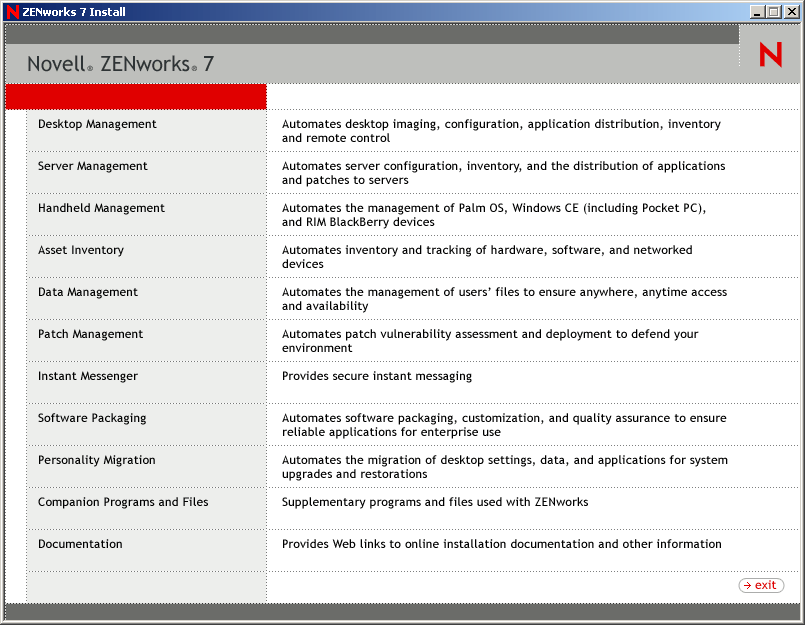
-
Click to display a page with options to install in various languages.
-
Click to display a page with Desktop Management installation options.
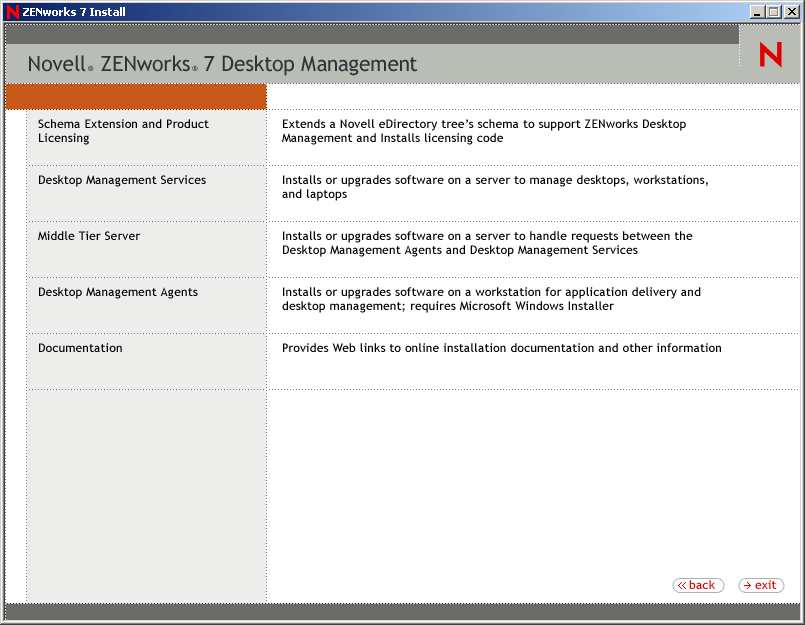
From this page, you can choose to either extend the schema before you actually install the new Desktop management product, or you can choose to extend the schema as part of the installation procedure.
9.1.1 Extending the Schema Before the Installation
If the network environment where you want to install the Desktop Management Server is a large tree, you might want to extend the schema and let the Novell eDirectory™ tree stabilize before you actually install the new Desktop Management product. To extend the schema first:
-
Select to launch the ZENworks Desktop Management Schema Extension and Product Licensing Wizard.
-
After you accept the terms of the license agreement and click , complete the eDirectory Tree for Creating Objects page of the wizard by browsing to or entering the name of an eDirectory tree where you want to add ZENworks Desktop Management schema extensions, select , then click .
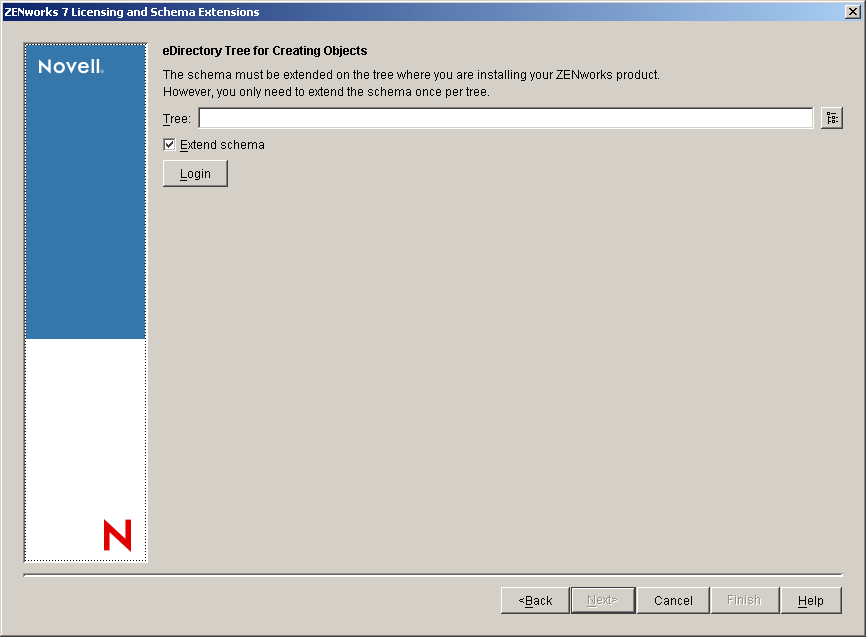
You need to extend the schema on a tree only once. You can authenticate to a tree by clicking the button and entering a user ID and password with the appropriate rights.
The duration of the schema extension operation depends on the size and complexity of your tree.
Both the Desktop Management Server installation program and the Middle Tier Server installation program allow you to select servers from only one eDirectory tree. If you run either of these installation program from a Windows server and if that server is not part of the tree you have selected, you cannot install the Desktop Management Server locally.
-
On the ZENworks License page, enter the license code that was e-mailed to you as part of the SmartCert product registration package, then click .
If you do not enter a license code on this page, the wizard considers this installation of ZENworks Desktop Management to be an evaluation version. If you install for an evaluation, you are periodically reminded to license the product. After 90 days, the product evaluation no longer functions.
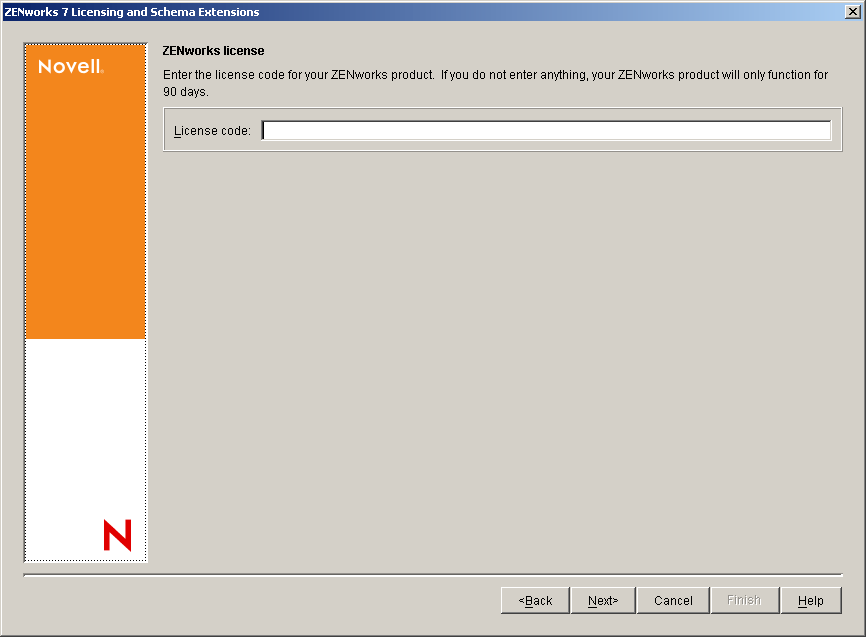
When the schema extension operation is complete, you can view a log file that is stored in c:\novell\zfdtemp\zwextsch.log.
9.1.2 Performing the Full Installation (Including Schema Extension)
If you want to install the Desktop Management Server software after extending the schema, or if you want to extend the schema of the tree as part of the installation, use the following steps:
-
Click to launch the Desktop Management Server installation wizard.
-
On the first Installation page, read the details about running the installation program, then click .
-
Read the License agreement, then click if you agree with the terms of the License Agreement.
If you do not agree with the terms of the license agreement, do not install the software.
-
On the Installation Requirements page, read the requirements for installing the Desktop Management Server software, make sure that the server where you plan to install meets the listed requirements, then click .
-
On the Tree Selection page, type or browse to the name of the Novell eDirectory tree where you want to install the Desktop Management Server. If you have not already extended the schema for this installation (see Section 9.1.1, Extending the Schema Before the Installation), select to extend the schema on the tree where you will be installing Desktop Management Server software, then click .
You cannot install Desktop Management Server software on multiple trees at the same time.
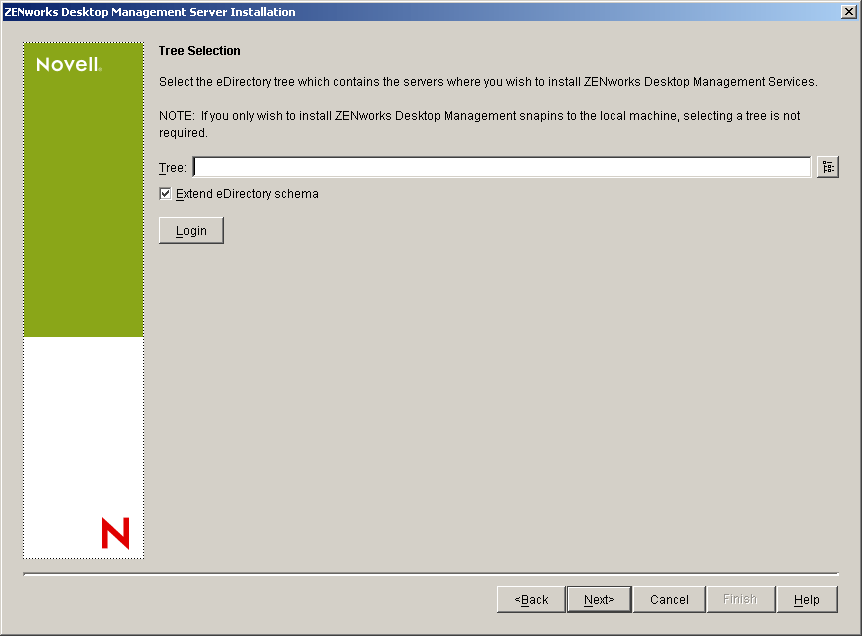
You need to extend the schema on a tree only once. You can authenticate to a tree by clicking the button and entering a user ID and password with the appropriate rights.
Both the Desktop Management Server installation program and the Middle Tier Server installation program allow you to select servers from only one eDirectory tree. If you run either of these installation program from a Windows server and if that server is not part of the tree you have selected, you cannot install the Desktop Management Server locally.
-
On the ZENworks Desktop Management Licensing page, specify the license code that was e-mailed to you as part of the SmartCert product registration package.
If you do not specify a license code on this page, the wizard considers this installation of ZENworks Desktop Management to be an evaluation version. If you install for an evaluation, you are periodically reminded to license the product. After 90 days, the product evaluation version no longer functions.

-
On the Server Selection page, click to browse to the names of the servers where you want to install Desktop Management Server software.
You can select servers only from the tree you selected in Step 5. You can install to up to 7 servers at a time.
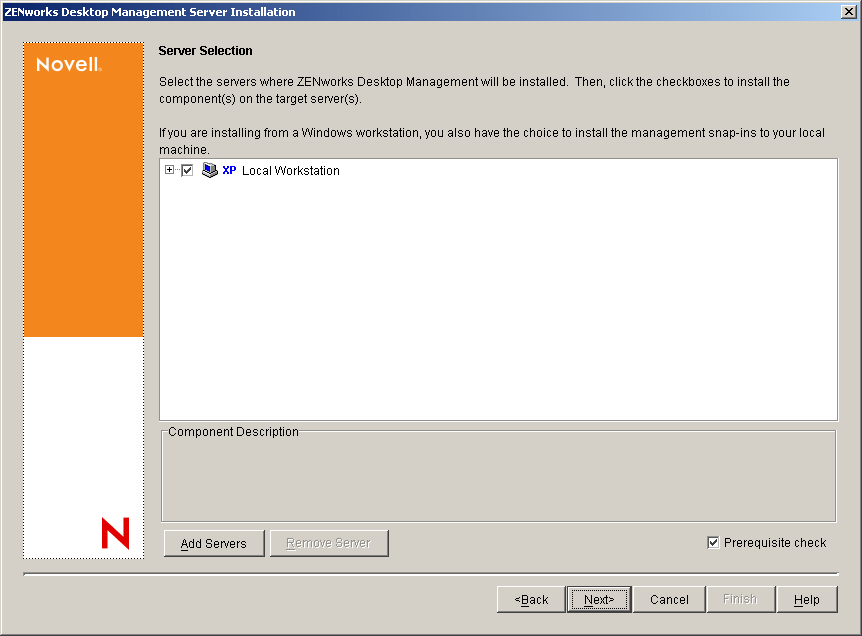
-
(Optional) In the Add Servers dialog box, you can list servers by their eDirectory tree names. To install to a server, select , browse to and click the name of the server you want to install to; or click to select all of the servers in a container, click the right-arrow button to move your selected servers to the Selected Servers pane, then click OK.
If you want to add a Windows server that you might not be authenticated to, you can double-click the server icon to display a dialog box where you can enter credentials to allow for Windows authentication.
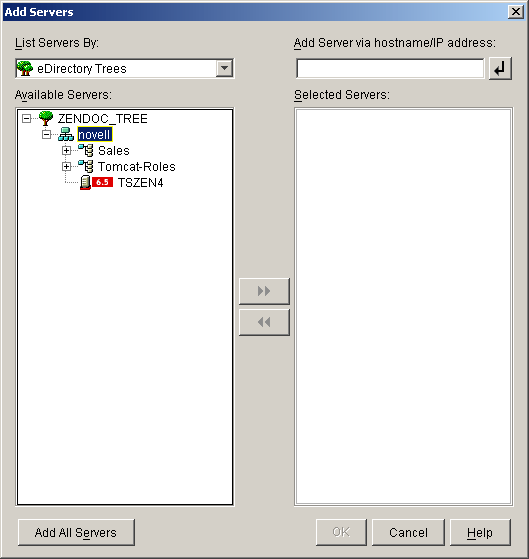
-
(Optional) In the Add Servers dialog box, you can specify the hostname or IP address of a server in the field. The value that you provide must be resolvable to the name of a server.
Click
 to begin the name resolution process and add the server to the list.
to begin the name resolution process and add the server to the list.
-
-
On the now-populated Server Selection page, you can further specify the services you want to install for the Desktop Management components you previously selected, then click to save your settings.
The list of settings includes the following:
Local Workstation: Even though the ConsoleOne® 1.3.6 installation program lets you install ConsoleOne files to a local hard drive (minor performance enhancements can be achieved by doing so) such an installation does not include the Desktop Management Services snap-ins.
You have the option of installing Desktop Management Services snap-ins to your local workstation by selecting under the option. ConsoleOne must be installed on the workstation before the snap-ins can be added.
Desktop Management Services: Desktop Management Services (collectively referred to as the “Desktop Management Server”) are commonly used files and programs that enable the configuration and distribution of workstation applications and policies. These services provide automatic management of Windows applications, user and workstation configurations, processes, and behaviors.
-
Application Management: Select this option to install software that enables the automated distribution, healing, and tracking of applications, updates, and patches.
-
Workstation Management Common Components: Select this option to install workstation-resident modules that are used to authenticate the user to the workstation and network, and used to transfer configuration information to and from eDirectory.
-
Remote Management: Select this component to install files and programs that enable the remote management of workstations from a central console. Make sure that the selected servers do not have the ZENworks for Servers 3.0.2 (or earlier) Remote Management component already installed.
Additional Options: If you want to customize your deployment of Desktop Management Services, there are a number of services to choose from, each with a specialized purpose.
-
Desktop Management Database: Select this option if you want to install a network database to be used by the Novell Application Launcher™ as a repository for data about application events (install, launch, cache, and so forth) that have occurred.
-
Inventory Database: Select this option if you want to install a network database to be used by Workstation Inventory as a repository for hardware and software inventory information collected from inventoried workstations.
IMPORTANT:If you want to use the Inventory database with an existing Oracle or MS SQL setup, do not select this option during the Server Inventory installation. Follow the steps in
Setting Up the Inventory Database
in the Novell ZENworks 7 Desktop Management Administration Guide. -
Inventory Server: Select this option if you want to install files and programs to enable the gathering and viewing of hardware and software inventory information for managed workstations.
If the selected servers have the Server Inventory component of ZENworks for Servers 3.0.2 or earlier installed, you must upgrade the component to ZENworks 7 Server Management.
-
Inventory Proxy Server: Select this option if you want to install a proxy service that enables the roll-up of inventory scan data to an Inventory server located across a network firewall. Make sure that the selected servers do not have the ZENworks for Servers 3.0.2 (or earlier) Inventory component already installed.
-
Imaging Server: Select this option if you want to install a Linux imaging environment to be used to create, store, send, or restore workstation image files to a workstation.
You should install the Imaging Server service and the PXE Server service on the same server; do not install the PXE Server service separately.
-
PXE Server: Select this option if you want to install Preboot Execution Environment (PXE) protocols and programs to be used by the server to communicate with a PXE-enabled workstation and to enable sending imaging tasks to that workstation.
When you install Preboot Services, one of the components that is installed is the Proxy DHCP server. If the standard DHCP server is on the same server where you are installing the Proxy DHCP server, you must set option tag 60 in DHCP services.
You should install the Imaging Server service and the PXE Server service on the same server; do not install the PXE Server service separately.
-
Workstation Import/Removal Server: Select this option if you want to install files and programs that add workstation objects into eDirectory (or remove those already added), where they can be managed to receive applications or computer settings.
-
Desktop Management Services Snap-Ins: Select this option if you want to install additions to ConsoleOne to enable you to launch Desktop Management tools and utilities, to view Desktop Management object property pages in eDirectory, and to browse and configure those objects.
You can perform a “custom selection” by selecting one or more servers and right-clicking to display a pop-up menu with options to add Database Services, Inventory Services, or Imaging Services to all of the servers you have selected. The option returns the selections to their initial state. The selection launches another dialog box that you can use to select specific components for all of the selected servers. This selection overrides any other selections you might have made.
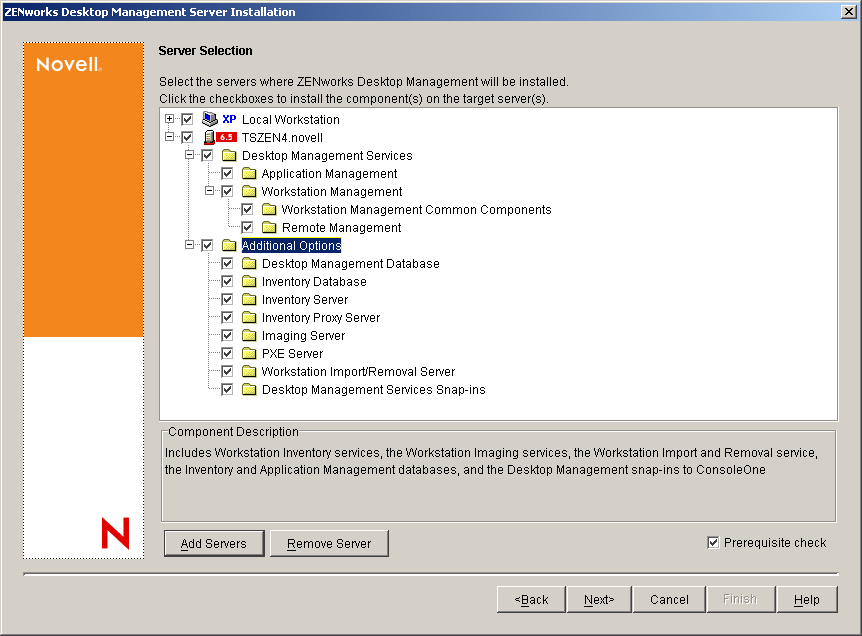
-
-
(Optional) The check box is selected by default. Retain the selection if you want the installation program to verify that the server or servers meet the installation requirements for ZENworks Desktop Management Services. The installation program checks the version of the server's network operating system (including any required service or support packs), the presence and version of the Novell Client (4.9 SP1a) on Windows servers and on the installing workstation, and the presence and version of ConsoleOne (1.3.6).
If the server operating system and support/service packs are not the correct version, the installation displays a warning message and does not continue until the required software is installed and detected or until you deselect the check box.
-
(Optional if Workstation Inventory or Remote Management is selected.) On the File Installation Location page, select one or more target servers in the list, then browse for or enter the volume or drive where you want the Workstation Inventory or Remote Management files to be installed. The default is SYS: for Novell NetWare and C: for Windows servers.
If a previous installation of ZENworks 7 Workstation Inventory or Remote Management component is detected on the machine, the existing path is displayed and dimmed. The current installation installs all the files in the same path.
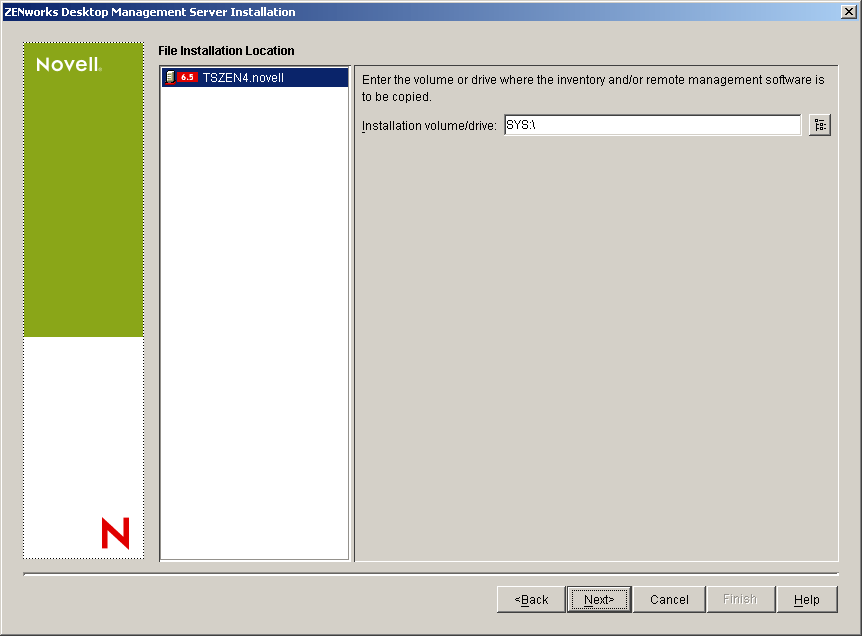
-
(Optional) The Database Location Installation page is displayed if you choose to install the Inventory database or the Desktop Management database. Select a previously designated server in the left pane, then in the field, browse for or type in the name of the volume or drive where the database file will be installed, then click .
You can provide a different volume or drive for each database server. For example, the volume names might be different on your various NetWare servers. However, you cannot have multiple instances of the database files on the same server, because you can run only one instance of the database engine per server. For NetWare servers, this path cannot include extended or double-byte characters.
SYS: is the default for NetWare servers. We recommend that you do not select SYS: on NetWare servers, because the database file can become large.
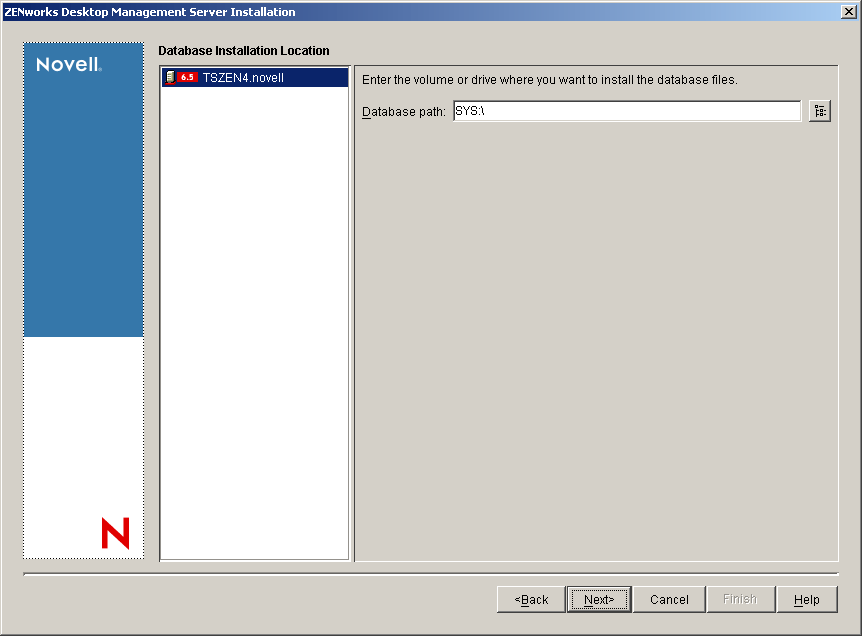
-
(Optional) The Inventory Standalone Configuration page is displayed if you choose to install the Inventory Server and the Inventory Database on the same server. If you want the installation program to automatically create the Server Package and the Database Location policy within the Server Package, and to start the Inventory Service on the server, configure the settings on the Inventory Standalone Configuration page.
Select , select the server or servers that you want to point to a common Database Location Search Policy, type in the name or browse to the tree container where you want to create and configure the Server Package containing this policy, then click .
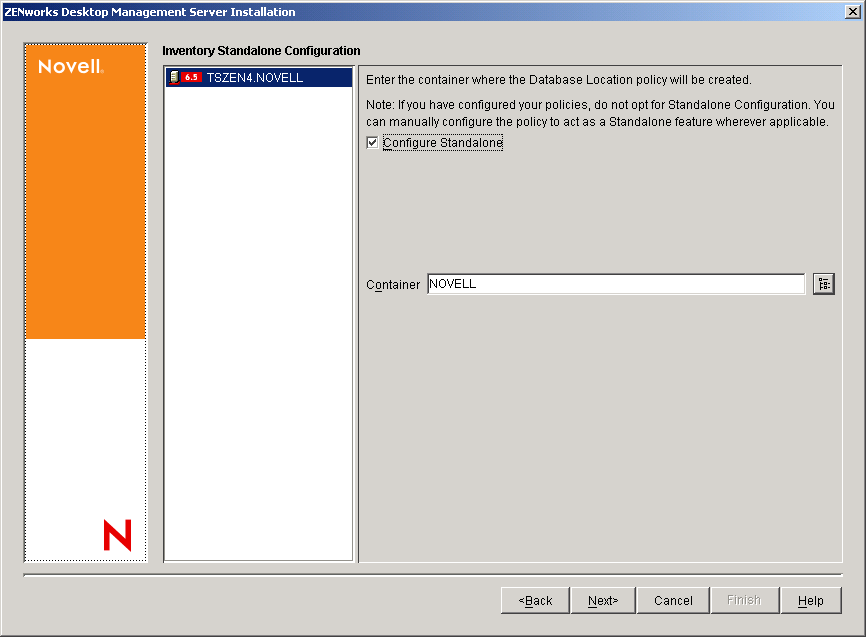
-
(Optional) On the Inventory Proxy Service Configuration page, select the server or servers with a port you want to designate as one to allow XMLRPC requests pass through to the Inventory Proxy service, then in the field, designate the port you want to use.
You can configure the same port number for all servers by selecting all of them, or you can define the values individually by selecting the servers one at a time. If you want to change the Port 65000 default, specify a value between 0 and 65535. Ensure that the port number is not used by other services on the server.

-
On the Summary page, review the list of components and their parts that are to be installed. If the summary is correct, click to launch the installation program.
You can click as many times as necessary to make changes.
If you click , no installation information is saved.
You can review the installation log file after the installation has completed. The log file name is datestamp_timestamp_zdmserver_install.log (for example: 20040304_024034_zdmserver_install.log). It is located in the \novell\zfdtemp directory on the machine you are installing from. This log file indicates whether any component failed to install.
You can also review the installation summary to review the selections you made. The summary is saved in a log file named datestamp_timestamp_zdmserver_installsummary.log (for example: 20040304_024034_zdmserver_installsummary.log). It is also located in c:\novell\zfdtemp.
-
In ConsoleOne, select the tree and container where you installed the Desktop Management Server software, then right-click the > click > .
Make sure that the option has been deselected for each server acting as the Authentication Domain for a ZENworks Middle Tier Server. If you need to set this parameter after you have installed the Desktop Management Server, make sure you reboot the ZENworks Middle Tier Server after you change the setting.
If you are installing to Windows servers in an Active Directory domain, configure the LDAP group object for servers that are to be used as Authentication Domains to use an alternate port number, because Active Directory uses ports 389 and 636.